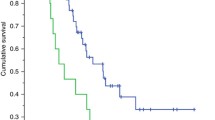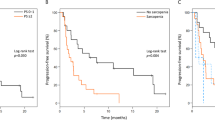Summary
Little is known on factors predicting toxicity of anti-PD1 checkpoint inhibitors. Sarcopenic obesity is associated with increased acute toxicity of cytotoxic agents and targeted therapies. We explored whether body composition also influenced the occurrence of early acute limiting toxicity (ALT) of anti-PD1 in melanoma patients. This is a monocentric, retrospective study analyzing toxicity outcome in consecutive melanoma patients treated with nivolumab or pembrolizumab. Various parameters linked to the patient or the disease status have been analysed. Body mass index (BMI; kg/m2) and muscle mass using CT were measured prior to treatment initiation. Chi-squared test and Mann-Whitney’s tests were used for the comparison of categorical and continuous variables respectively. Among 68 melanoma patients treated with anti-PD1 (47 pembrolizumab, 21 nivolumab), 38 (56%) patients had a BMI ≥ 25 kg/m2 and 11 (16%) a BMI ≥ 30, while 13 (19%) had both sarcopenia and a BMI ≥ 25 kg/m2. For the 11 (16%) patients who experienced early ALT, the mean BMI was higher (27.9 versus 24.7 kg/m2; p = 0.04). Among the 32 female patients, sarcopenic overweight patients had a 6.5-fold increased risk of ALT (50 versus 7.7%; p = 0.01). Sarcopenic overweight is associated with more early ALT of anti-PD1 in melanoma patients.


Similar content being viewed by others
References
Ribas A, Puzanov I, Dummer R et al (2015) Pembrolizumab versus investigator-choice chemotherapy for ipilimumab-refractory melanoma (KEYNOTE-002): a randomised, controlled, phase 2 trial. Lancet Oncol 16:908–918. doi:10.1016/S1470-2045(15)00083-2
Robert C, Schachter J, Long GV et al (2015) Pembrolizumab versus Ipilimumab in Advanced Melanoma. N Engl J Med 372:2521–2532. doi:10.1056/NEJMoa1503093
Robert C, Long GV, Brady B et al (2015) Nivolumab in previously untreated melanoma without BRAF mutation. N Engl J Med 372:320–330. doi:10.1056/NEJMoa1412082
Weber JS, D’Angelo SP, Minor D et al (2015) Nivolumab versus chemotherapy in patients with advanced melanoma who progressed after anti-CTLA-4 treatment (CheckMate 037): a randomised, controlled, open-label, phase 3 trial. Lancet Oncol 16:375–384. doi:10.1016/S1470-2045(15)70076-8
Huillard O, Mir O, Peyromaure M et al (2013) Sarcopenia and body mass index predict sunitinib-induced early dose-limiting toxicities in renal cancer patients. Br J Cancer 108:1034–1041. doi:10.1038/bjc.2013.58
Prado CMM, Baracos VE, McCargar LJ et al (2007) Body composition as an independent determinant of 5-fluorouracil-based chemotherapy toxicity. Clin Cancer Res Off J Am Assoc Cancer Res 13:3264–3268. doi:10.1158/1078-0432.CCR-06-3067
Michot JM, Bigenwald C, Champiat S et al (1990) (2016) immune-related adverse events with immune checkpoint blockade: a comprehensive review. Eur J Cancer Oxf Engl 54:139–148. doi:10.1016/j.ejca.2015.11.016
Mourtzakis M, Prado CMM, Lieffers JR et al (2008) A practical and precise approach to quantification of body composition in cancer patients using computed tomography images acquired during routine care. Appl Physiol Nutr Metab Physiol Appliquée Nutr Métabolisme 33:997–1006. doi:10.1139/H08-075
Prado CMM, Lieffers JR, McCargar LJ et al (2008) Prevalence and clinical implications of sarcopenic obesity in patients with solid tumours of the respiratory and gastrointestinal tracts: a population-based study. Lancet Oncol 9:629–635. doi:10.1016/S1470-2045(08)70153-0
Barret M, Antoun S, Dalban C et al (2014) Sarcopenia is linked to treatment toxicity in patients with metastatic colorectal cancer. Nutr Cancer 66:583–589. doi:10.1080/01635581.2014.894103
Jung H-W, Kim JW, Kim J-Y et al (2015) Effect of muscle mass on toxicity and survival in patients with colon cancer undergoing adjuvant chemotherapy. Support Care Cancer Off J Multinatl Assoc Support Care Cancer 23:687–694. doi:10.1007/s00520-014-2418-6
Tan BHL, Brammer K, Randhawa N et al (2015) Sarcopenia is associated with toxicity in patients undergoing neo-adjuvant chemotherapy for oesophago-gastric cancer. Eur J Surg Oncol J Eur Soc Surg Oncol Br Assoc Surg Oncol 41:333–338. doi:10.1016/j.ejso.2014.11.040
Ali R, Baracos VE, Sawyer MB et al (2016) Lean body mass as an independent determinant of dose-limiting toxicity and neuropathy in patients with colon cancer treated with FOLFOX regimens. Cancer Med 5:607–616. doi:10.1002/cam4.621
Sjøblom B, Grønberg BH, Wentzel-Larsen T et al (2016) Skeletal muscle radiodensity is prognostic for survival in patients with advanced non-small cell lung cancer. Clin Nutr Edinb Scotl. doi:10.1016/j.clnu.2016.03.010
Antoun S, Baracos VE, Birdsell L et al (2010) Low body mass index and sarcopenia associated with dose-limiting toxicity of sorafenib in patients with renal cell carcinoma. Ann Oncol Off J Eur Soc Med Oncol ESMO 21:1594–1598. doi:10.1093/annonc/mdp605
Mir O, Coriat R, Blanchet B et al (2012) Sarcopenia predicts early dose-limiting toxicities and pharmacokinetics of Sorafenib in patients with hepatocellular carcinoma. PLoS One. doi:10.1371/journal.pone.0037563
Massicotte M-H, Borget I, Broutin S et al (2013) Body composition variation and impact of low skeletal muscle mass in patients with advanced medullary thyroid carcinoma treated with vandetanib: results from a placebo-controlled study. J Clin Endocrinol Metab 98:2401–2408. doi:10.1210/jc.2013-1115
Martin L, Birdsell L, Macdonald N et al (2013) Cancer cachexia in the age of obesity: skeletal muscle depletion is a powerful prognostic factor, independent of body mass index. J Clin Oncol Off J Am Soc Clin Oncol 31:1539–1547. doi:10.1200/JCO.2012.45.2722
Go S, Park MJ, Song H et al (2016) Prognostic impact of sarcopenia in patients with diffuse large B-cell lymphoma treated with rituximab plus cyclophosphamide, doxorubicin, vincristine, and prednisone. J Cachex Sarcopenia Muscle. doi:10.1002/jcsm.12115
Kumar A, Moynagh MR, Multinu F et al (2016) Muscle composition measured by CT scan is a measurable predictor of overall survival in advanced ovarian cancer. Gynecol Oncol. doi:10.1016/j.ygyno.2016.05.027
Sabel MS, Lee J, Cai S et al (2011) Sarcopenia as a prognostic factor among patients with stage III melanoma. Ann Surg Oncol 18:3579–3585. doi:10.1245/s10434-011-1976-9
Wagner D, DeMarco MM, Amini N et al (2016) Role of frailty and sarcopenia in predicting outcomes among patients undergoing gastrointestinal surgery. World J Gastrointest Surg 8:27–40. doi:10.4240/wjgs.v8.i1.27
Downey SG, Klapper JA, Smith FO et al (2007) Prognostic factors related to clinical response in patients with metastatic melanoma treated by CTL-associated antigen-4 blockade. Clin Cancer Res Off J Am Assoc Cancer Res 13:6681–6688. doi:10.1158/1078-0432.CCR-07-0187
Yousaf N, Davidson M, Goode E et al (2015) The cost of ipilimumab toxicity: a single-centre analysis. Melanoma Res 25:259–264. doi:10.1097/CMR.0000000000000158
Author information
Authors and Affiliations
Corresponding author
Ethics declarations
Conflict of interest
All the authors have no conflict of interest to declare related to the work described in the paper.
Funding
This work has received no funding.
Ethical approval
All procedures performed in studies involving human participants were in accordance with the ethical standards of the institutional and/or national research committee and with the 1964 Helsinki declaration and its later amendments or comparable ethical standards.
This article does not contain any studies with animals performed by any of the authors.
Informed consent
For this type of study, formal consent is not required.
Additional information
The original version of this article was revised due to first and last names have been reversed in the list of authors.
An erratum to this article is available at http://dx.doi.org/10.1007/s10637-017-0475-7.
Rights and permissions
About this article
Cite this article
Heidelberger, V., Goldwasser, F., Kramkimel, N. et al. Sarcopenic overweight is associated with early acute limiting toxicity of anti-PD1 checkpoint inhibitors in melanoma patients. Invest New Drugs 35, 436–441 (2017). https://doi.org/10.1007/s10637-017-0464-x
Received:
Accepted:
Published:
Issue Date:
DOI: https://doi.org/10.1007/s10637-017-0464-x




